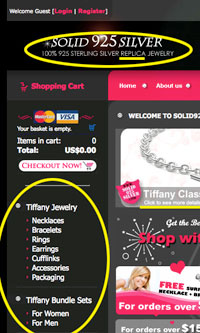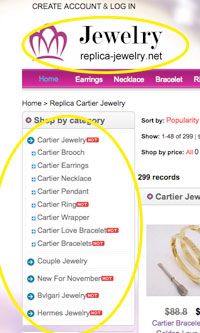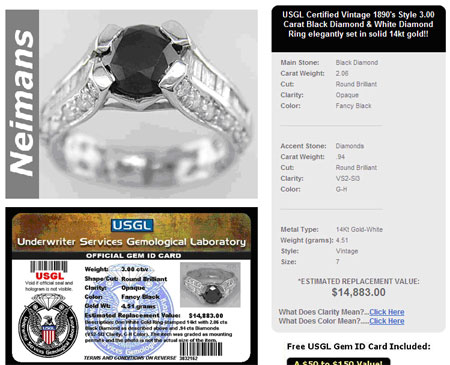The Hazard of Fakes
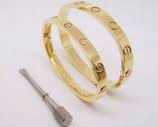 Owners of a Los Angeles store recently pleaded guilty to selling knock-off designer jewelry. The press said they were selling “hazardous fakes” because the jewelry, manufactured abroad, contained 20 times the amount of lead considered acceptable in the U.S.
Owners of a Los Angeles store recently pleaded guilty to selling knock-off designer jewelry. The press said they were selling “hazardous fakes” because the jewelry, manufactured abroad, contained 20 times the amount of lead considered acceptable in the U.S.
Even without the toxic lead, counterfeit jewelry is hazardous–to honest jewelers, who must compete in price with low-quality rip-offs; to consumers, who may think they're getting real designer jewelry at bargain prices; and to insurers, who can wind up paying outrageous settlements for fake merchandise.
Traffic in counterfeit goods, especially luxury goods like jewelry, is big business. And a fast-growing chunk of that business is on the internet.
Name Brands
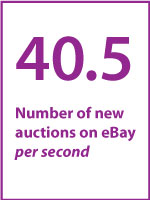 For several years, Tiffany & Co. has been engaged in lawsuits against eBay over counterfeit Tiffany jewelry sold on the site. Tiffany accused eBay of profiting from trademark infringement, false advertising, and deceiving customers.
For several years, Tiffany & Co. has been engaged in lawsuits against eBay over counterfeit Tiffany jewelry sold on the site. Tiffany accused eBay of profiting from trademark infringement, false advertising, and deceiving customers.
The last in a series of court decisions came down in September: Tiffany lost on all counts.
The court said that eBay did not sell counterfeit goods; only the fraudulent vendors did. It agreed with eBay's defense that it functions as a marketplace, like a flea market, not as a seller.
Tiffany alone has forced eBay to shut down more than 19,000 auctions and estimates that 95% of “Tiffany” jewelry advertised on eBay is counterfeit. Other designers may not have similar resources to police the net, as millions of new auction sites spring up every day.
Note that the Tiffany-eBay suit revolved around who should police the sites for fraud; neither side disputed that there was fraud going on.
What this means for consumers who buy any jewelry from online auctions sites is a major warning: Internet Buyers Beware! What it means for insurers is: be very cautious about insuring those goods.
Replicas
When it comes to name brand jewelry, “replica” is another word for “fake.” A number of websites openly sell replica jewelry. These sellers are not trying to fool the buyer–but beware that the buyer doesn't try to fool the insurer. Always check for evidence of authenticity.
“Certified” Diamonds
The word “certified” offers a sense of security and can put buyers off their guard, but it can cover a variety of frauds. As we've often warned, a diamond certificate is only as good as the lab that issues it.
Bogus certificates, produced by unreliable labs, are commonplace on the Internet as well as in brick-and-mortar stores. Retailers can buy diamond reports in bulk to accompany stones that were never examined by a gemologist. Such certificates also include a valuation, which a reliable lab's certificate will not do. Both the quality of the jewelry and its valuation are likely to be grossly exaggerated, for these certificates function as sales tools. They serve as evidence that the purchase is a bargain because the selling price is well below the jewelry's “appraised value.”
This ring, for example, which sold on the internet for $400, came with an “estimated replacement value” of 37 times the selling price!
Suppose an insurer accepted this USGL valuation of $14,883. The buyer would then be paying $200-$300 in annual premiums. Would anyone insure a $400 purchase at these premiums - unless they saw an opportunity? Such grossly exaggerated valuation is a moral hazard to insurers.
Forgeries. More sophisticated scams involve forgeries of certificates from reliable labs. These forgeries are done primarily to cheat the buyer, but of course they can ultimately cheat the insurer. GIA is such a recognized and respected name that its reports are often accepted without question, making them popular targets for forgery.
AGS, GCAL, and Gübelin, as well as GIA, produce reliable diamond reports. Be sure to verify the authenticity of any certificates using the links below.
FOR AGENTS & UNDERWRITERS
A good tip to pass on to your clients: When buying jewelry, always pay by credit card. Then immediately get an appraisal from an independent appraiser, who is a Graduate Gemologist and preferably a CIA™. Paying by cc is the buyer's best protection if the quality and valuation of the jewelry does not match the seller's claims.
Don't take brand names at face value. There is big money in faking big name jewelry.
Be wary of high-value jewelry from unauthorized dealers, especially second-hand sites.
A reliable gem-certifying lab is one that has built a reputation for accuracy and impartiality. Do not rely on certificates, lab reports, gem cards, gem i.d. cards, or other such documents from labs other than those listed below.
RELIABLE LABS
GIA (Gemological Institute of America) GIA Report Check
AGS Laboratories AGS Report Verification
GCAL (Gem Certification and Assurance Lab) GCAL Certificate Search
Gübelin Gem Lab (based in Switzerland) Gübelin Gem Lab
These are the ONLY labs we can recommend for reliable diamond certificates. For high-value stones, insist on a report from one of these reputable labs. And verify the authenticity of the report on the lab’s Web site, using the links.
FOR ADJUSTERS
Was the jewelry purchased on eBay (or anywhere on the internet)?
If so, be very suspicious of the stated quality and valuation. If it was a trademark brand, it is likely not to be genuine. Use every means to verify authenticity.
Is the valuation on a printed certificate/report/ID card supplied by the seller?
Disregard this valuation, as such papers function as sales tools. Try to determine value based on descriptive information and sale price.
If necessary, consult a jewelry insurance expert to help determine value. Valuations from eBay jewelry auctions are often grossly inflated.
Is it a brand name?
Look for evidence of authenticity. Some manufacturers sell only through authorized dealers. Merchandise bought online (or from other unauthorized sources) may be second-hand, or may be altered with cheaper parts, may have been sold openly as a replica, or may be a complete knockoff wearing an important logo.
Have all damaged jewelry examined in a gem lab to be sure the quality is as stated. For brand-name jewelry, be sure to have the piece examined by an authorized dealer of that brand to ensure all parts are authentic.
©2000-2025, JCRS Inland Marine Solutions, Inc. All Rights Reserved. www.jcrs.com

